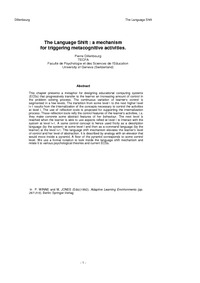The Language Shifta mechanism for triggering metacognitive activities
Erstpublikation in: in P. WINNE and M. JONES (Eds)(1992). Adaptive Learning Envirtonments
Publikationsdatum:
|
 |
 Diese Seite wurde seit 3 Jahren inhaltlich nicht mehr aktualisiert.
Unter Umständen ist sie nicht mehr aktuell.
Diese Seite wurde seit 3 Jahren inhaltlich nicht mehr aktualisiert.
Unter Umständen ist sie nicht mehr aktuell.
 Zusammenfassungen
Zusammenfassungen
 This chapter presents a metaphor for designing educational computing systems
(ECSs) that progressively transfer to the learner an increasing amount of control in
the problem solving process. The continuous variation of learner's control is
segmented in a few levels. The transition from some level i to the next higher level
i+1 results from the internalization of the concepts necessary to control the activities
at level i. The use of reflection tools is proposed for supporting the internalization
process. These reflection tools reify the control features of the learner's activities, i.e.
they make concrete some abstract features of her behaviour. The next level is
reached when the learner is able to use aspects refied at level i to interact with the
system at level i+1. A same control concept is hence used firstly as a description
language (by the system) at some level i and then as a command language (by the
learner) at the level i+1. This language shift mechanism elevates the learner's level
of control and her level of abstraction. It is described by analogy with an elevator that
would move inside a pyramid. A floor of the pyramid corresponds to some control
level. We use a formal notation to look inside the language shift mechanism and
relate it to various psychological theories and current ECSs.
This chapter presents a metaphor for designing educational computing systems
(ECSs) that progressively transfer to the learner an increasing amount of control in
the problem solving process. The continuous variation of learner's control is
segmented in a few levels. The transition from some level i to the next higher level
i+1 results from the internalization of the concepts necessary to control the activities
at level i. The use of reflection tools is proposed for supporting the internalization
process. These reflection tools reify the control features of the learner's activities, i.e.
they make concrete some abstract features of her behaviour. The next level is
reached when the learner is able to use aspects refied at level i to interact with the
system at level i+1. A same control concept is hence used firstly as a description
language (by the system) at some level i and then as a command language (by the
learner) at the level i+1. This language shift mechanism elevates the learner's level
of control and her level of abstraction. It is described by analogy with an elevator that
would move inside a pyramid. A floor of the pyramid corresponds to some control
level. We use a formal notation to look inside the language shift mechanism and
relate it to various psychological theories and current ECSs. Dieser Text erwähnt ...
Dieser Text erwähnt ...
 Begriffe KB IB clear | Metakognitionmetacognition , microworldmicroworld , Zone of Proximal Development |
 Volltext dieses Dokuments
Volltext dieses Dokuments
 |  The Language Shift: Artikel als Volltext ( The Language Shift: Artikel als Volltext ( : :  , 79 kByte; , 79 kByte;  : :  2021-03-21) 2021-03-21) |
 Anderswo suchen
Anderswo suchen 
 Beat und dieser Text
Beat und dieser Text
Beat war Co-Leiter des ICT-Kompetenzzentrums TOP während er Dieser Text ins Biblionetz aufgenommen hat. Die bisher letzte Bearbeitung erfolgte während seiner Zeit am Institut für Medien und Schule. Beat besitzt kein physisches, aber ein digitales Exemplar. Eine digitale Version ist auf dem Internet verfügbar (s.o.). Aufgrund der wenigen Einträge im Biblionetz scheint er es nicht wirklich gelesen zu haben. Es gibt bisher auch nur wenige Objekte im Biblionetz, die dieses Werk zitieren.









 Biblionetz-History
Biblionetz-History